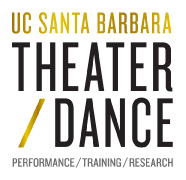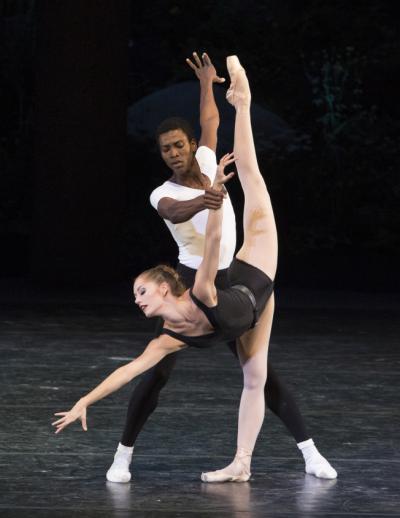2019 International Colloquium
Dance and Performance Studies
Race, Ballet, and American Dance
Monday, April 29, 2019
9:00 a.m. to 5:00 p.m. followed by a Reception
All events are free and take place in the HSSB Ballet Studio
George Balanchine’s Agon (1957)
Jerome Robbins’ Afternoon of a Faun (1953)
Staged by
Ms. Heather Watts, Former Principal Dancer, the New York City Ballet
Performed by
Calvin Royal III, Principal Dancer, the American Ballet Theatre
Unity Phelan, Soloist, the New York City Ballet
Cameron Grant, Solo Pianist, the New York City Ballet
Performance and Keynote by
Alicia Graf Mack, Chair of Dance, The Juilliard School
Former Principal Dancer, The Dance Theatre of Harlem, Alvin Ailey American Dance Theater and Alonzo King/LINES
Films of Arthur Mitchell and Company
Keynote Address by the Distinguished Ballet Scholar
Lynn Garafola (Professor Emerita, Dance History, Columbia University)
Co-Curated by
Stephanie Batiste (Associate Professor, English Literature/Black Studies)
Ninotchka D. Bennahum (Professor, Dance Studies/Performance Studies)
Project Rationale and Objectives
Race & Ballet is an all-day conference and performance considering how race and racism have been both institutionalized and subverted within the idiom of American classical ballet. The inaugural event of the International Colloquium in Dance and Performance Studies, Race & Ballet honors the work of former Principal Dancer of the New York City Ballet, Ms. Heather Watts and two Principal Dancers whose dance art brings the issue of race to the fore. Calvin Royal III, Principal Dancer, American Ballet Theatre, and Unity Phelan, Soloist, the New York City Ballet, come together at Ms. Watts’ direction, along with New York City Ballet concert pianist Cameron Grant, a veteran of Balanchine’s artistic team, to perform Jerome Robbins’ Afternoon of a Faun (1953) and George Balanchine’s Agon (1957) and initiate a discussion about Balanchine, Robbins, and the Civil Rights Era.
The April 29, 2019 Race & Ballet International will deepen our collective understanding of the crucial role played by dance artists in the shaping of racial perception in the United States. History is written dancing bodies. Artists and scholars participating in Race & Ballet will illuminate through keynote talks, roundtables, and performance how major and minor dance artists, choreographers the likes of Agnes de Mille, Jerome Robbins, George Balanchine, Antony Tudor, Bronislava Nijinska, and Kyle Abraham, have committed their choreographic practice to political defiance through radical acts of resistant, corporeal struggle.
Project History
In the fall of 2017, Lynn Garafola, Heather Watts and I began to discuss issues of race, racism and classical and contemporary ballet. Prompted by Ms. Heather Watts’ Agon lecture-demonstration at City Center and Professor Garafola’s 2018 exhibition, Arthur Mitchell: Harlem’s Trailblazer at Columbia University’s Wallach Gallery, the graduate faculty in Dance, Theater, and Performance Studies decided to bring a Race and Ballet conference to the University of California, Santa Barbara on Monday, April 29, 2019. Race & Ballet inaugurates the Department of Theater and Dance’s International Colloquium in Dance and Performance Studies.
The Colloquium scholars will examine how racism has been institutionalized within American classical ballet. From the segregationist legal code of the antebellum era to the more nuanced casting decisions by major ballet companies, the idiom of classical ballet was and, to some extent, remains a reflection of Americans’ continuously complex views of race in the post-Civil Rights era. Revivals of the famous 19 th century ballet blanc - La Sylphide, Giselle, La Bayadère and Swan Lake - white-tutu’d Romantic 19 th century classics were transported to the 20 th century, their all-white “Russian” corps de ballet lines in tact. Except that classical ballet was never solely about whiteness. Ballets’ long lines of white-clothed women told an entirely different story, one of unattainable female creatures whose transcendentalist escapism was meant more as political critique than as the reinforcement of white supremacy.
Yet, in the United States, early 20 th century impresarios and ballet artists refocused the artform on the issue of skin color, white privilege and race relations, exacerbated by legal code and southern racism and intolerance. Ideas about ethereal white Christian chastity already in play in many Romantic works were now understood as mirrors into a segregated society’s own complex relationship to black dancing bodies, practically erased from public space, except for the courage and talent of a handful of dancers whose technical virtuosity and moral courage earned them spots in America’s top dance companies: the Metropolitan Opera Ballet, the (American) Ballet Theatre, the Joffrey Ballet, and the New York City Ballet. Raven Wilkinson, Mary Hinkson, Janet Collins, Francísco Moncion, Alicia and Fernando Alonso, Nicholas Magallenes, and Arthur Mitchell are a few dance artists (whose names we know) able to break down the color barrier in classical ballet.
Program
9:00 a.m. Welcome John Majewski, Michael Douglas Dean of Humanities And Fine Arts
9:10 a.m. Welcome Christina McCarthy, Director of Dance
9:15 a.m. Introductory Remarks Ninotchka Bennahum, Race & Ballet on the American Professor Stage Dance Studies/ Performance Studies
9:30 a.m. Filmic Interlude Stormy Weather. Choreographic excerpt by Katherine Dunham.
Performed by Katherine Dunham and members of the Katherine Dunham Company.
Directed by Andrew L. Stone. Twentieth Century-Fox in 1943.
9:35 a.m. Balm in Gilead (1998)
Choreography by Arthur Mitchell
Performed by Alicia Graf Mack
Music by Jessye Norman
9:40 a.m. Alicia Graf Mack in Conversation with Lynn Garafola
Q + A with students/audience
10:15 a.m. The Arc (2018) Choreography and performance by Alicia Graf Mack.
Somewhere Over the Rainbow sung by Sarah Vaughn.
Music by Harold Arlen. Lyrics by Yip Harburg for the film The Wizard of Oz 1939.
10:25 a.m. Filmic Interlude
10:30 a.m. Hollywood, Race, and American Dance
Bruce Robertson, Director, Art, Design Architecture Museum
10:50 a.m. Filmic Interlude
11:00 a.m. Artists’ Roundtable: Heather Watts and Stephanie Batiste in conversation with Calvin Royal III, Unity Phelan, Alicia Graf Mack with Stephanie Batiste, and Heather Watts
12:00 p.m. Filmic Interlude
12:10 p.m. Lunch
1:15 p.m. Keynote lecture: Heather Watts on Jerome Robbins
Afternoon of a Faun (1953), choreography by Jerome Robbins
Music by Claude Debussy
Danced by Unity Phelan, Soloist, the New York City Ballet Calvin Royal III, Soloist, American Ballet Theatre
Piano, Cameron Grant, New York City Ballet Orchestra
2:00 p.m. Filmic Interlude – Afternoon of a Faun
2:05 p.m. The African American Presence in Lynn Garafola, Postwar American Ballet Professor Emerita Columbia University, Barnard College
Coffee Break
3:15 p.m. Agon (1957), choreography by George Balanchine
Music by Igor Stravinsky
Danced by Unity Phelan, Soloist, New York City Ballet
Calvin Royal III, Soloist, American Ballet Theatre
Piano, Cameron Grant, New York City Ballet Orchestra
3:55 p.m. Artist-Scholar Roundtable: Alicia Graf Mack, Unity Phelan, Cameron Grant, Calvin Royal, Stephanie Batiste, Heather Watts, Lynn Garafola, Ninotchka Bennahum
5:00 p.m. Reception






